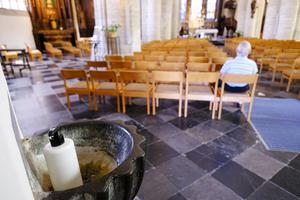NYC Mayor de Blasio Defends Decision Not to Pay for Coronavirus Testing at Private Schools
The legal fight comes amid new public health measures from Gov. Andrew Cuomo, which included additional testing requirements for schools open for in-person learning in certain zones of the city with higher infection rates.

MANHATTAN — New York City Mayor Bill de Blasio is defending his decision not to extend state funding for on-site coronavirus testing to students in Catholic schools, as he fights a court mandate that the state department of education provide testing to both private and public school students.
“We believe the law is clear that it is not the city’s obligation to provide the actual testing service,” de Blasio told the New York Post Dec. 1.
“Our obligation right now is to continue the process of having New York City public schools be open and healthy and safe.”
In a lawsuit filed Nov. 18, the Archdiocese of New York argued that the New York City Department of Education has a legal mandate to provide children attending nonpublic schools within their districts with “all of the health and welfare services” they provide to their public school students, including “the administration of health screening tests.”
The archdiocese cited burdensome costs associated with the increased testing requirements, which at public schools are covered by the state.
On Nov. 24, the New York State Supreme Court ruled in favor of the archdiocese. The DOE is appealing the ruling, and de Blasio said Dec. 1 that he interprets the state law in question, Section 912, differently.
The legal fight comes amid new public health measures from Gov. Andrew Cuomo, which included additional testing requirements for schools open for in-person learning in certain zones of the city with higher infection rates.
“Yellow zone” restrictions include a 25-person maximum capacity on gatherings, 4-person to a table maximum while dining, and weekly testing for at least 20% of in-person students and faculty in all schools.
If the results of the testing reveal that the positivity rate among the 20% of those tested is lower than the yellow zone's current 7-day positivity rate, testing at that school will no longer be required to continue, the state said in a Nov. 14 guidance.
The 172 Catholic schools in the New York archdiocese have been open for in-person instruction since September.
According to a Nov. 30 op-ed by archdiocesan school superintendent Michael Deegan, their schools’ positivity rate is significantly below the 3 percent threshold, at 0.0046 percent.
“The mayor has been on the news lately, saying (rightly) that the key to reopening schools is testing and more testing,” Deegan wrote.
“That’s great to hear. Why, then, are he and [schools chancellor Richard] Carranza so dead-set against following state law, now backed by a court order, requiring public and nonpublic kids to receive the same testing resources?”
"Do Mayor de Blasio and his schools chancellor, Richard Carranza, really believe that children in nonpublic schools deserve inferior measures to protect their health? Apparently," Deegan stated.
On Nov. 18, de Blasio announced that the city’s public schools would “temporarily” suspend in-person classes. He subsequently announced Nov. 29 that he would allow elementary school and pre-K students to return to in-person learning Dec. 7, with special education students returning Dec. 10.
The initial decision to suspend in-person learning in public schools was made after one set of data found that the city’s coronavirus test positivity rate was 3%. Metrics shared by Cuomo at a press conference following the decision to close, however, stated that the city’s positivity rate was 2.5%, not yet at the anticipated threshold for school closure. De Blasio also announced Nov. 29 that the 3% threshold would no longer be used.
De Blasio has faced criticism for his treatment of houses of worship during the coronavirus pandemic, threatening mass arrests or even permanent closure of churches and synagogues that did not comply with public orders.
De Blasio said in June that ongoing protests in the city merit exceptions to coronavirus regulations, while religious services do not, drawing criticism from the New York archdiocese.
The Supreme Court ruled in late November that New York state restrictions during the coronavirus pandemic are a violation of the First Amendment’s protection of free religious exercise.
The state’s restrictions forbade the attendance of more than 10 people at religious services in state designated “red zones, and 25 people in “orange zones.”
In a statement Nov. 26, Bishop Nicholas DiMarzio of Brooklyn said he is “gratified by the decision of the Justices of the United States Supreme Court, who have recognized the clear First Amendment violation and urgent need for relief in this case.”
The court’s ruling is temporary, as lawsuits filed by the Diocese of Brooklyn and by Orthodox Jewish synagogues in New York will continue, though the Supreme Court’s Nov. 26 decision is likely to weigh heavily in the outcome of those cases.
While cases of coronavirus have continued to spike throughout the country, schools have largely not been the sources of these infections.
Last month, Cuomo was part of a bipartisan group of governors from the northeast who signed a statement calling in-person learning the “best possible scenario” for children.
- Keywords:
- covid-19
- testing
- nyc catholic schools
















